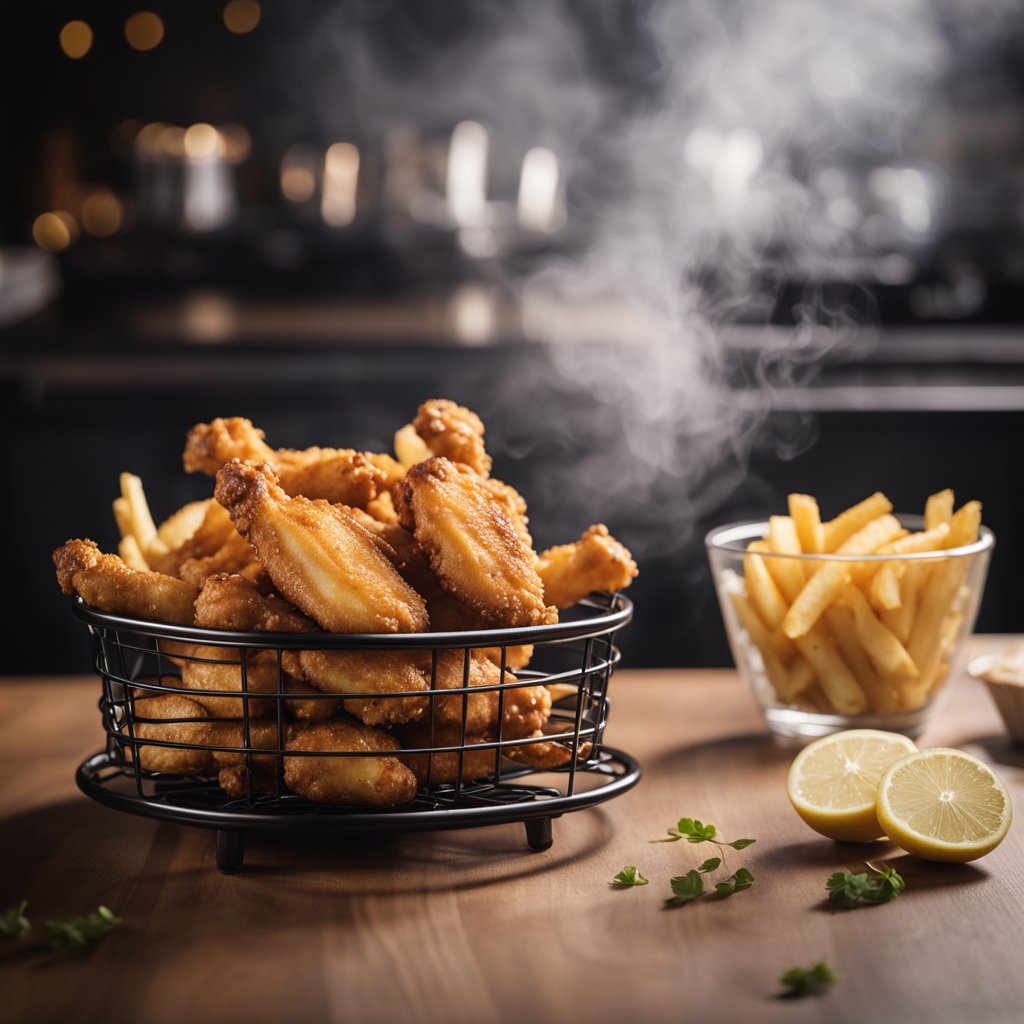Rust can be a common nuisance for kitchen knives, diminishing their appearance, performance, and longevity. Understanding why rust forms and how to effectively remove it can restore your knives to their former glory and ensure they remain reliable tools in your culinary arsenal. This article will delve into the science of rust formation, preventative measures, cleaning techniques, and maintenance tips to keep your knives in top condition.
Contents
- 1 Key Takeaways
- 2 Understanding Rust Formation on Kitchen Knives
- 3 Preventative Measures to Avoid Rust
- 4 Effective Cleaning Techniques for Rust Removal
- 5 Maintaining Your Knives Post-Cleaning
- 6 Conclusion
- 7 Frequently Asked Questions
- 7.1 Why do kitchen knives rust, and how can I prevent it?
- 7.2 Is rust on kitchen knives harmful to my health?
- 7.3 How should I clean my kitchen knives to avoid rust?
- 7.4 What are the consequences of improperly maintaining kitchen knives?
- 7.5 What is the recommended way to store kitchen knives?
- 7.6 How often should I sharpen my kitchen knives and how do I test their sharpness?
Key Takeaways
- Drying your knife immediately after washing is crucial to prevent rust, especially for high carbon steel knives.
- Using knives only for their intended purpose and avoiding misuse can significantly reduce the risk of damage and rust.
- Regular cleaning with warm soapy water followed by thorough drying is essential for knife maintenance.
- Proper storage using a knife sheath, magnetic bar, or roll bag can help maintain the knife’s condition and sharpness.
- Sharpening your knives regularly and testing for sharpness before use will ensure optimal performance and safety.
Understanding Rust Formation on Kitchen Knives
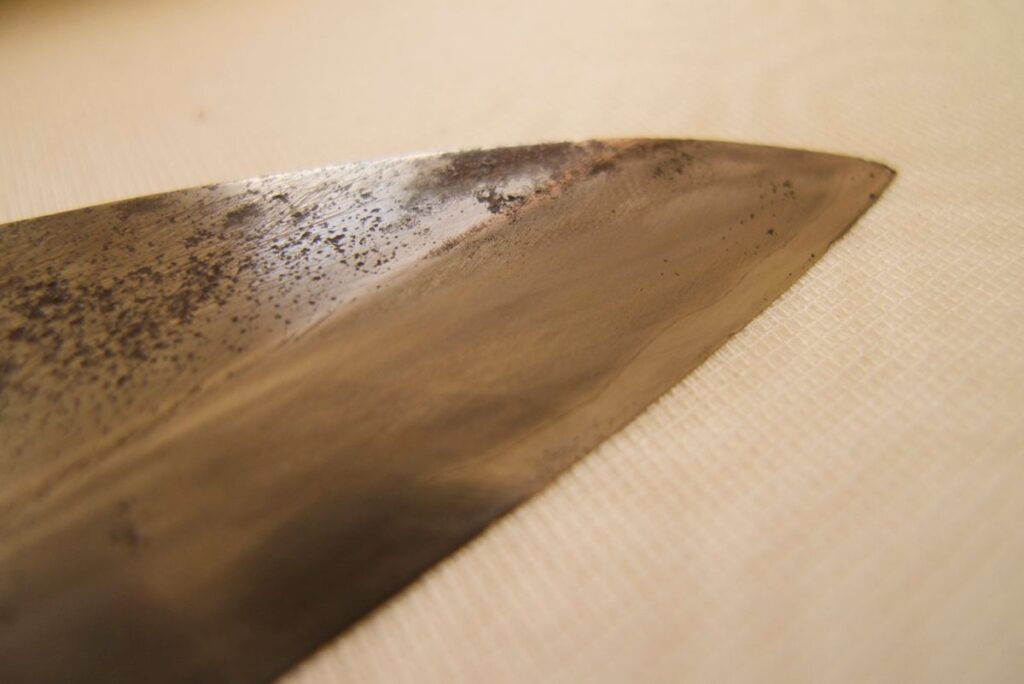
The Science Behind Rusting
Rust is the common term for the corrosion and oxidation of iron and its alloys. When kitchen knives are exposed to moisture and oxygen, an electrochemical process begins, leading to the formation of rust. This process is exacerbated by the presence of salts and acids, which can often be found in food residues.
- Keep knives dry to prevent rust.
- Salts and acids accelerate rusting.
- Moisture and oxygen are the culprits.
Rust not only affects the appearance of a knife but also its performance. A rusty blade can become dull and uneven, increasing the risk of accidents during use.
Understanding the science of rusting is crucial for maintaining the integrity of your kitchen knives. By keeping them dry and clean, you can significantly reduce the likelihood of rust formation.
Factors That Contribute to Rust
Understanding the factors that lead to rust is crucial for maintaining your kitchen knives. Water and oxygen are the primary agents that cause rust to form on knives. When these elements come into contact with the iron in the steel, they initiate a chemical reaction that results in rust. This process is accelerated in environments with high humidity or when knives are left wet.
Humidity and exposure to acidic foods can also increase the likelihood of rust formation. Even knives made with stainless steel, known for their resistance to rust, can succumb to these conditions if not properly cared for. Below is a list of common factors that contribute to rust on kitchen knives:
- Prolonged exposure to moisture
- Contact with acidic substances
- Lack of proper drying after washing
- Storing in damp or unventilated areas
It’s essential to keep knives dry and store them in a way that minimizes exposure to these rust-promoting conditions.
High Carbon vs. Stainless Steel Knives
When choosing a kitchen knife, understanding the difference between high carbon and stainless steel is crucial. High carbon knives are renowned for their sharpness and durability but require more meticulous care to prevent rust. Stainless steel knives, on the other hand, boast superior corrosion resistance due to their chromium content, making them less prone to rusting.
- High carbon knives need to be dried immediately after washing to avoid rust.
- Stainless steel knives can develop rust stains but are generally more forgiving.
Both types of knives demand proper maintenance to ensure longevity and optimal performance.
Choosing the right knife depends on your cooking habits and willingness to perform regular maintenance. While high carbon knives can offer exceptional cutting experiences, stainless steel knives provide ease of care for the busy cook.
Preventative Measures to Avoid Rust
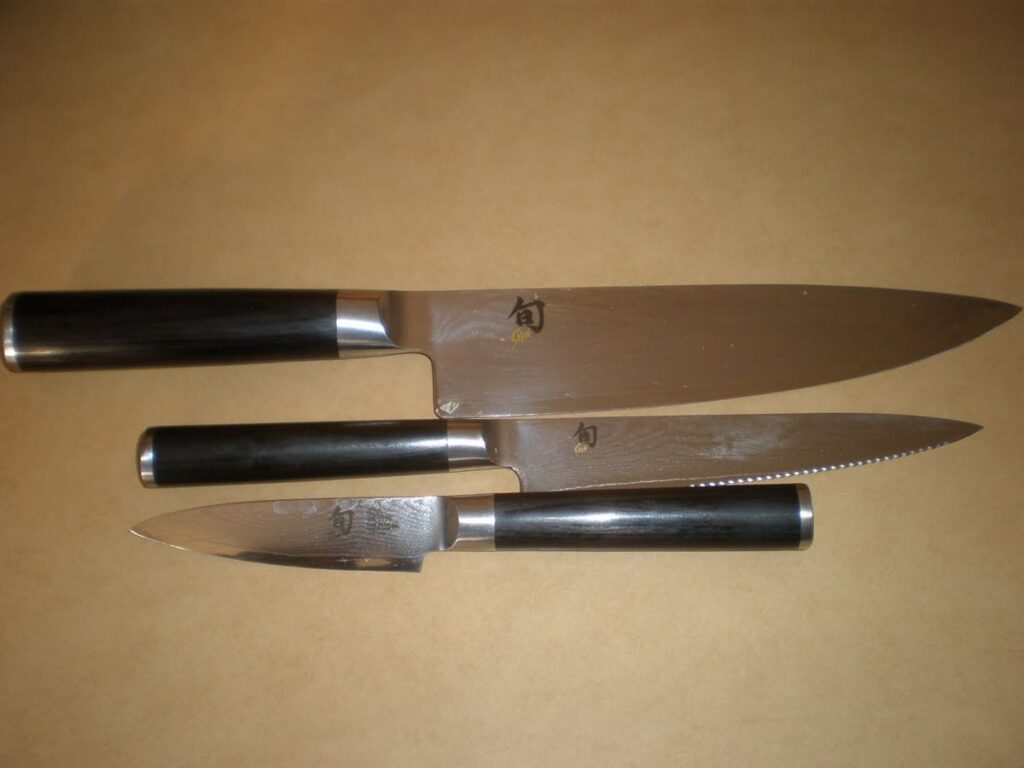
Proper Knife Usage
Only use kitchen knives for their intended purpose, such as cutting food. Misusing knives for non-food tasks can lead to damage and make maintenance difficult. For example, avoid using your knife to open packages or cut through frozen food, as this can dull the blade and cause unnecessary wear.
Proper knife usage is crucial for maintaining a sharp edge and preventing rust. Always use a cutting board to protect the blade and never use your knife to pry open cans or other containers.
- Do not use knives for non-food related tasks
- Always use a cutting board
- Avoid using knives to pry things open
By adhering to these simple guidelines, you can extend the life of your kitchen knives and keep them in optimal condition.
Immediate Cleaning and Drying
To prevent rust, immediately dry your knives after washing. Use warm soapy water and a soft towel to clean them. Avoid letting knives sit damp in a drying rack; instead, dry them with a towel right after washing.
Moisture is the enemy of a pristine blade. Even stainless steel knives can succumb to rust if not kept dry. High carbon knives are particularly vulnerable and require prompt and thorough drying.
The real key to knife maintenance is not just washing, but ensuring the knife is completely dry immediately afterwards.
For best practices, consider the following steps:
- Wash knives by hand with dish soap and water.
- Use a soft sponge; avoid abrasive tools like steel wool.
- Dry knives immediately after washing to prevent rust formation.
Appropriate Storage Solutions
Ensuring your kitchen knives are stored correctly is crucial for both safety and longevity. Avoid stacking knives on top of each other as this can lead to blade damage and pose safety risks. Instead, consider using a knife sheath, magnetic knife bar, or a roll bag. These methods prevent the blades from touching each other, reducing the risk of dulling or chipping.
Knife blocks are commonly used but can have downsides. They may require the purchase of additional tools and can harbor bacteria in their slots. To keep knives in optimal condition, dry them immediately after washing and before storing.
The right storage solution not only protects the knives but also ensures they are always ready for use, sharp, and safe to handle.
Effective Cleaning Techniques for Rust Removal
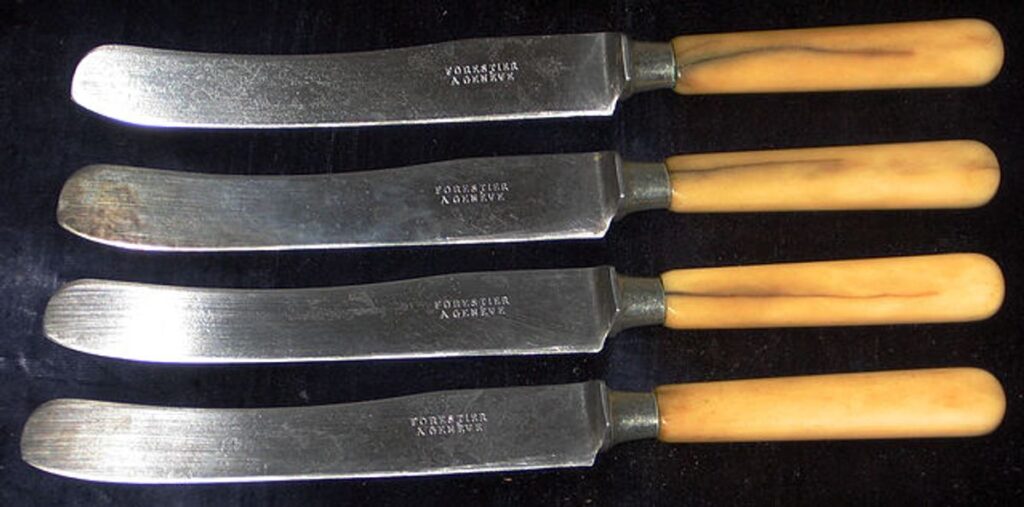
Materials and Tools Needed
Before you begin the rust removal process, gather the necessary materials and tools. Ensure you have a non-abrasive cleaning pad to avoid scratching the knife’s surface. A rust eraser is an excellent tool for targeting rust spots without damaging the blade. For stubborn rust, consider using a specialized rust remover solution.
- Non-abrasive cleaning pad
- Rust eraser
- Rust remover solution
- Soft cloth for drying
- Mineral oil for blade protection
It’s crucial to select tools that are gentle on the knife’s metal while effective against rust.
Step-by-Step Cleaning Process
Once you’ve gathered your materials, it’s time to tackle the rust. Start by making a paste with baking soda and a little water. Apply this mixture generously over the rusted areas of the knife. Allow the paste to sit for about an hour, giving it ample time to penetrate and loosen the rust.
After the waiting period, gently scrub the rusted areas with a soft brush or cloth. The goal is to remove the rust without scratching the knife’s surface. Rinse the knife thoroughly with water to remove any residue from the cleaning process.
Ensure the knife is completely dry after rinsing. Any remaining moisture can lead to further rusting, so take extra care during the drying phase.
Finally, inspect the knife for any remaining rust spots. If necessary, repeat the cleaning process until the knife is rust-free. Once satisfied, move on to drying and polishing the knife to restore its shine.
Drying and Polishing After Cleaning
After the rust has been removed, immediately dry your knife with a soft towel to prevent new rust from forming. Moisture is the enemy of a clean knife, so ensure no water remains on the blade or handle.
Polishing your knife not only restores its shine but also provides a protective layer against future rust. Use a microfiber cloth and a suitable polish for kitchen knives to give your blade a smooth finish.
After drying and polishing, inspect your knife for any remaining moisture or rust spots. Address these immediately to maintain the integrity of the blade.
For ongoing protection, consider applying a thin layer of mineral oil to the blade. This acts as a barrier against moisture and can help keep your knife in pristine condition.
- Dry the knife with a soft towel
- Polish with a microfiber cloth and knife polish
- Inspect the knife for moisture or rust
- Apply a thin layer of mineral oil for protection
Maintaining Your Knives Post-Cleaning
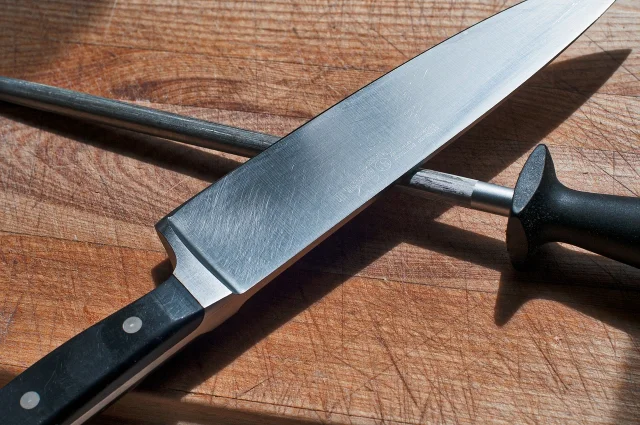
Regular Sharpening and Honing
Sharpening your knives is not just about maintaining a sharp edge; it’s about ensuring safety and precision in the kitchen. A well-honed blade reduces the risk of accidents and improves cutting efficiency. Here’s a simple guide to keeping your knives in prime condition:
- Test knife sharpness regularly to determine if sharpening is needed.
- Use a honing rod weekly to maintain the edge and prevent dullness.
- Sharpen knives two to three times a year for occasional home use.
- Consider professional sharpening services for the best results.
A dull knife is more dangerous than a sharp one. Regular maintenance keeps your knives ready for any culinary challenge.
Testing knife sharpness is a crucial step before starting any cutting task. A sharp knife should glide through paper or a tomato with ease. If the blade struggles, it’s time to sharpen. Remember, a well-maintained knife is a chef’s best tool.
Testing Knife Sharpness
After sharpening, testing your knife’s sharpness is crucial to ensure optimal performance. A simple yet effective method is the paper test. Hold a piece of paper upright and slice through it with the knife. A sharp knife should cut cleanly without tearing.
Testing Sharpness:
- Slice through paper
- Cut a tomato
- Shave arm hair
A dull knife is more dangerous than a sharp one as it requires more force and can slip more easily.
Always test sharpness before starting your culinary tasks to maintain safety and precision. If the knife fails the paper test, it may need further honing or professional sharpening.
Ongoing Care and Maintenance Tips
Consistent care is the cornerstone of knife longevity. Always dry your knives immediately after washing to prevent moisture from lingering and causing rust. Use a soft towel to avoid scratching the blade.
For storage, consider a knife sheath or magnetic bar over traditional knife blocks, which can harbor bacteria and dull your blades. Sharpening should be a regular part of your routine; a well-maintained edge is safer and more efficient.
A dull knife is more dangerous than a sharp one. Keeping your knives sharp reduces the risk of accidents and ensures a pleasurable cooking experience.
Here’s a quick checklist for ongoing maintenance:
- Inspect knives for rust or damage regularly.
- Hone the blade before each use to maintain its edge.
- Store knives in a dry, safe place.
- Sharpen your knives as needed to keep them in optimal condition.
Conclusion
In conclusion, maintaining your kitchen knives free from rust is crucial for their longevity and your safety. Remember to wash and immediately dry your knives after use to prevent rust formation. If rust does occur, it’s not a disaster, but it’s best to address it promptly to preserve the blade’s sharpness and ensure ease of use. Proper usage, such as avoiding non-food-related tasks, and correct storage, like using a knife sheath or magnetic bar, are also key to preventing damage and rust. Regular sharpening and testing for sharpness will keep your knives in top condition. By following these expert tips from Chef Dumapit, you can ensure your kitchen knives remain rust-free and ready for any culinary challenge.
Frequently Asked Questions
Why do kitchen knives rust, and how can I prevent it?
Kitchen knives rust due to a chemical reaction between iron, oxygen, and moisture. To prevent rust, keep your knives dry, especially high carbon knives, and avoid leaving them damp in a drying rack. Use them only for cutting food and clean and dry immediately after use.
Is rust on kitchen knives harmful to my health?
Trace amounts of rust on kitchen knives are not typically harmful to health, but rusty knives can be harder to work with, leading to a duller blade and increased risk of injury.
How should I clean my kitchen knives to avoid rust?
Clean your knives with warm soapy water and a towel right after use. Do not put them in a drying rack; instead, dry them immediately with a towel to prevent rust formation.
What are the consequences of improperly maintaining kitchen knives?
Improper maintenance can lead to dull blades, increasing the risk of injury, and rust that can spoil meals. It’s essential to wash and dry knives properly and use them only for their intended purpose.
What is the recommended way to store kitchen knives?
Use a knife sheath, magnetic knife bar, or a roll bag for storing kitchen knives. Avoid knife blocks as they can harbor bacteria and may require additional unnecessary tools.
How often should I sharpen my kitchen knives and how do I test their sharpness?
Sharpen your knives often to ensure proper performance. Test sharpness before use to confirm they are ready for the task. Regular sharpening and honing will maintain the knife’s edge and safety.

